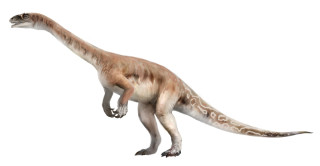Seitaad ruessi

Name: Seitaad ruessi
(Pronunciation: SAY-todd ROO-ess-EYE)
Age: Early Jurassic (~185 million years ago)
Where It's Found in Utah: Comb Ridge, San Juan County.
Geologic Formation: Navajo Sandstone (near the lower contact with the Kayenta Formation)
Classification: Saurischia - Sauropodomorpha – Massospondylidae
Description: At just over 10 feet (3 meters) long from tip of the snout to the tip of the tail, Seitaad might not look much like the hulking titans Camarasaurus and Brachiosaurus, but they actually belong to the same group of dinosaurs, called sauropodomorphs. Seitaad is one of the many early branches of this evolutionary tree that are often called ‘prosauropods’. It had a long neck and tail like later sauropod dinosaurs, but was much smaller and still walked on two legs. Also, unlike sauropods, Seitaad had grasping hands with large curved claws, perhaps for digging or defending itself. Although the skull of Seitaad was not preserved, we know from related species found in Africa and South America that it ate plants like its gigantic descendants.
Why It’s a Top NHMU Dinosaur: The only known fossil skeleton of Seitaad is in NHMU collections! It is the oldest named dinosaur species ever found in Utah. There are older dinosaur remains known, but they’re too fragmentary to give a name to. Seitaad was discovered by local artist Joe Pachek. NHMU paleontologists excavated it from rocks that are 185 million year old sand dunes, and NHMU volunteer Jerry Golden spent hundreds of hours in the lab slowly removing rock from around the bones to expose the skeleton. Although the head, neck, and tail had eroded away prior to discovery, the remaining bones were articulated, meaning they were still in live position and had not been shifted by scavengers, flowing water, or erosion. Because it was found in 185 million year old sand dunes, researchers named Seitaad after a sand monster in Navajo sacred stories. The species name, ruessi, honors the early 20th century explorer, artist, and author Everett Ruess, who disappeared in 1934 while exploring southern Utah.
Where Can I See It?: The Land Gallery at the Natural History Museum of Utah.
Suggested Reading/References:
Sertich, J. J. W., and M. A. Loewen. 2010. A new basal sauropodomorph dinosaur from the Lower Jurassic Navajo Sandstone of southern Utah. PLoS One 5:e9789, 1-17.
University of Utah. New Dinosaur from Utah’s Red Rocks: Plant-Eater Named for Vanished Explorer Everett Ruess.
Credits:
Image: © Victor Leshyk
Author: Randall Irmis, Curator of Paleontology at the Natural History Museum of Utah (2012)